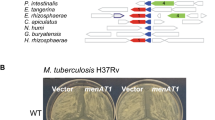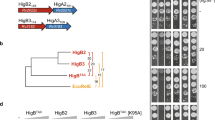Abstract
The Escherichia coli chromosome encodes toxin-antitoxin pairs. The toxin RelE cleaves mRNA positioned at the A-site in ribosomes, whereas the antitoxin RelB relieves the effect of RelE. The hyperthermophilic archaeon Pyrococcus horikoshii OT3 has the archaeal homologs aRelE and aRelB. Here we report the crystal structure of aRelE in complex with aRelB determined at a resolution of 2.3 Å. aRelE folds into an α/β structure, whereas aRelB lacks a distinct hydrophobic core and extensively wraps around the molecular surface of aRelE. Neither component shows structural homology to known ribonucleases or their inhibitors. Site-directed mutagenesis suggests that Arg85, in the C-terminal region, is strongly involved in the functional activity of aRelE, whereas Arg40, Leu48, Arg58 and Arg65 play a modest role in the toxin's activity.
This is a preview of subscription content, access via your institution
Access options
Subscribe to this journal
Receive 12 print issues and online access
$189.00 per year
only $15.75 per issue
Buy this article
- Purchase on Springer Link
- Instant access to full article PDF
Prices may be subject to local taxes which are calculated during checkout




Similar content being viewed by others
Accession codes
References
Gerdes, K. Toxin-antitoxin modules may regulate synthesis of macromolecules during nutritional stress. J. Bacteriol. 182, 561–572 (2000).
Galvani, C., Terry, J. & Ishiguro, E.E. Purification of the RelB and RelE proteins of Escherichia coli: RelE binds to RelB and to ribosomes. J. Bacteriol. 183, 2700–2703 (2001).
Gotfredsen, M. & Gerdes, K. The Escherichia coli relBE genes belong to a new toxin-antitoxin gene family. Mol. Microbiol. 29, 1065–1076 (1998).
Christensen, S.K., Mikkelsen, M., Pedersen, K. & Gerdes, K. RelE, a global inhibitor of translation, is activated during nutritional stress. Proc. Natl. Acad. Sci. USA 98, 14328–14333 (2001).
Bech, F.W., Jorgensen, S.T., Diderichsen, B. & Karlstrom, O.H. Sequence of the relB transcription unit from Escherichia coli and identification of the relB gene. EMBO J. 4, 1059–1066 (1985).
Masuda, Y., Miyakawa, K., Nishimura, Y. & Ohtsubo, E. chpA and chpB, Escherichia coli chromosomal homologs of the pem locus responsible for stable maintenance of plasmid R100. J. Bacteriol. 164, 1124–1135 (1993).
Aizenman, E., Engelberg-Kulka, H. & Glaser, G. An Escherichia coli chromosomal 'addiction module' regulated by guanosine 3′,5′-bispyrophosphate: a model for programmed bacterial cell death. Proc. Natl. Acad. Sci. USA 93, 6059–6063 (1996).
Grady, R. & Hayes, F. Axe-Txe, a broad-spectrum proteic toxin-antitoxin system specified by a multidrug resistant, clinical isolate of Enterococcus faecium. Mol. Microbiol. 47, 1419–1432 (2003).
Pedersen, K., Christensen, S.K. & Gerdes, K. Rapid induction and reversal of a bacteriostatic condition by controlled expression of toxins and antitoxins. Mol. Microbiol. 45, 501–510 (2002).
Pedersen, K. et al. The bacterial toxin RelE displays codon-specific cleavage of mRNAs in the ribosomal A site. Cell 112, 131–140 (2003).
Christensen, S.K., Pedersen, K., Hansen, G.H. & Gerdes, K. Toxin-antitoxin loci as stress-responsible-elements. ChpAK/MazF and ChpBK cleave translated RNAs and are counteracted by tmRNA. J. Mol. Biol. 332, 809–819 (2003).
Zhang, Y. et al. MazF cleaves cellular mRNAs specifically at ACA to block protein synthesis in Escherichia coli. Mol. Cell 12, 913–923 (2003).
Kamada, K., Hanaoka, F. & Burley, S.K. Crystal structure of the Maz/MazF complex: molecular bases of antidote-toxin recognition. Mol. Cell 11, 875–884 (2003).
de la Cueva-Mendez, G. Distressing bacteria. Structure of a prokaryotic detox program. Mol. Cell 11, 848–850 (2003).
Christensen, S.K. & Gerdes, K. RelE toxins from bacteria and archaea cleave mRNAs on translating ribosomes, which are rescued by tmRNA. Mol. Microbiol. 48, 1389–1400 (2003).
Takagi, H. et al. Crystal structure of the ribonuclease P protein Ph1877p from hyperthermophilic archaeon Pyrococcus horikoshii OT3. Biochem. Biophys. Res. Commun. 319, 787–794 (2004).
Kakuta, Y. et al. Crystal structure of the regulatory subunit of archaeal initiation factor 2B (aIF2B) from hyperthermophilic archaeon Pyrococcus horikoshii OT3: a proposed structure of the regulatory subcomplex of eukaryotic IF2B. Biochem. Biophys. Res. Commun. 319, 725–732 (2004).
Kawarabayashi, Y. et al. Complete genome sequence of an aerobic thermoacidophilic crenarchaeon, Sulfolobus tokodaii strain 7. DNA Res. 8, 123–140 (2001).
Holm, L. & Sander, C. Protein structure comparison by alignment of distance matrices. J. Mol. Biol. 233, 123–138 (1993).
Buckle, A.M., Schreiber, G. & Fersht, A.R. Protein-protein recognition: crystal structural analysis of a barnase–barstar complex at 2.0-Å resolution. Biochemistry 33, 8878–8889 (1994).
Kolade, O.O. et al. Structural aspects of the inhibition of DNase and rRNase colicins by their immunity proteins. Biochimie 84, 439–446 (2002).
Graille, M., Mora, L., Buckingham, R.H., van Tilbeurgh, H. & Zamaroczy, M. Structural inhibition of the colicin D tRNase by the tRNA-mimicking immunity protein. EMBO J. 23, 1474–1482 (2004).
Landschulz, W.H., Johnson, P.F. & McKnight, S.L. The DNA binding domain of the rat liver nuclear protein C/EBP is bipartite. Science 243, 1681–1688 (1989).
Vinson, C.R., Sigler, P.B. & McKnight, S.L. Scissors-grip model for DNA recognition by a family of leucine zipper proteins. Science 246, 911–246 (1989).
Weiss, M.A., Ellenberger, T., Wobbe, C.R., Lee, J. P, Harrison, S.C. & Struhl, K. Folding transition in the DNA-binding domain of GCN4 on specific binding to DNA. Nature 347, 575–578 (1990).
Ellenberger, T.E., Brandl, C.J., Struhl, K. & Harrison, S.C. The GCN4 basic region leucine zipper binds DNA as a dimer of uninterrupted a helices: crystal structure of the protein–DNA complex. Cell 71, 1223–1237 (1992).
Saudek, V. et al. Solution structure of the basic region from the transcriptional activator GCN4. Biochemistry 30, 1310–1317 (1991).
Nissen, P. et al. Crystal structure of the ternary complex of Phe-tRNAPhe, EF-Tu, and a GTP analog. Science 270, 1464–1472 (1995).
Song, H. et al. The crystal structure of human eukaryotic release factor eRF1-mechanism of stop codon recognition and peptidyl-tRNA hydrolysis. Cell 100, 311–321 (2000).
Vestergaard, B. et al. Bacterial polypeptide release factor RF2 is structurally distinct from eukaryotic eRF1. Mol. Cell 8, 1375–1382 (2001).
Selmer, M., Al-Karadaghi, S., Hirokawa, G., Kaji, A. & Liljas A. Crystal structure of Thermotoga maritime ribosome recycling factor: a tRNA mimic. Science 286, 2349–2352 (1999).
Nakamura, Y. & Ito, K. Making sense of mimic in translation termination. Trends Biochem. Sci. 28, 99–105 (2003).
Ito, K., Ebihara, K., Uno, M. & Nakamura, Y. Conserved motifs of prokaryotic and eukaryotic polypeptide release factors: tRNA-protein mimicry hypothesis. Proc. Natl. Acad. Sci. USA 93, 5443–5448 (1996).
Wilson, K.S. & Noller, H.F. Mapping the position of translational elongation factor EF-G in the ribosome by directed hydroxyl radical probing. Cell 92, 131–139 (1998).
Otwinowski, Z. & Minor, W. Processing of X-ray diffraction data collected in oscillation mode. Methods Enzymol. 276, 307–326 (1997).
Terwilliger, T.C. & Berendzen, J. Automated MAD and MIR structure solution. Acta Crystallogr. D 55, 849–861 (1999).
Jones, T.A., Zou, J.Y., Cowan, S.W. & Kjeldgaard, M. Improved methods for building protein models in electron density maps and the location of errors in these models. Acta Crystallogr. A 47, 110–119 (1991).
Brunger, A.T. et al. Crystallography & NMR system: a new software suite for macromolecular structure determination. Acta Crystallogr. D 54, 905–921 (1998).
Laskowski, R.A., MacArthur, M.W., Moss, D.S. & Thornton, J.M. PROCHECK: a program to check the stereochemical quality of protein structures. J. Appl. Cryst. 26, 283–291 (1993).
Wower, I.K., Zwieb, C.W., Guven, S.A. & Wower, J. Binding and cross-linking of tmRNA to ribosomal protein S1, on and off the Escherichia coli ribosome. EMBO J. 19, 6612–6621 (2000).
Acknowledgements
We thank N. Shimizu (Japan Synchrotron Radiation Research Institute) for help with data collection using synchrotron radiation at beamline BL40B2. We are grateful to M. Ohara (Fukuoka) for helpful comments on the manuscript. This work was supported in part by a grant from the National Project on Protein Structural and Functional Analyses from the Japan Ministry of Education, Culture, Sports, Science and Technology.
Author information
Authors and Affiliations
Corresponding author
Ethics declarations
Competing interests
The authors declare no competing financial interests.
Supplementary information
Supplementary Fig. 1
Viable count. (PDF 53 kb)
Supplementary Fig. 2
Sequence comparison. (PDF 28 kb)
Supplementary Table 1
Major interactions. (PDF 20 kb)
Rights and permissions
About this article
Cite this article
Takagi, H., Kakuta, Y., Okada, T. et al. Crystal structure of archaeal toxin-antitoxin RelE–RelB complex with implications for toxin activity and antitoxin effects. Nat Struct Mol Biol 12, 327–331 (2005). https://doi.org/10.1038/nsmb911
Received:
Accepted:
Published:
Issue Date:
DOI: https://doi.org/10.1038/nsmb911
This article is cited by
-
Identification and Characterization of HEPN-MNT Type II TA System from Methanothermobacter thermautotrophicus ΔH
Journal of Microbiology (2023)
-
Functional characterization of HigBA toxin-antitoxin system in an Arctic bacterium, Bosea sp. PAMC 26642
Journal of Microbiology (2022)
-
Type II toxin–antitoxin system in bacteria: activation, function, and mode of action
Biophysics Reports (2020)
-
Comparative genomics reveals the presence of putative toxin–antitoxin system in Wolbachia genomes
Molecular Genetics and Genomics (2018)
-
Complete genome sequence and pathogenic genes analysis of Pectobacterium atroseptica JG10-08
Genes & Genomics (2017)



